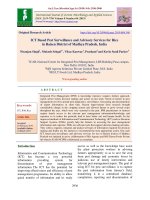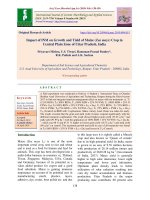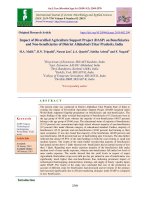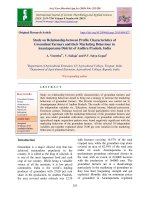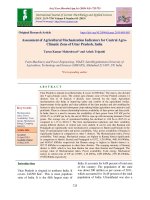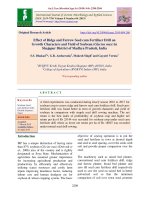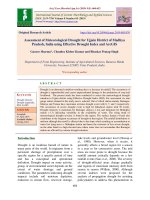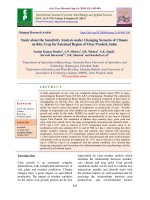Performance of wheat under alkali water and gypsum application in central plain zone of Uttar Pradesh, India
Bạn đang xem bản rút gọn của tài liệu. Xem và tải ngay bản đầy đủ của tài liệu tại đây (158.86 KB, 5 trang )
Int.J.Curr.Microbiol.App.Sci (2017) 6(3): 2300-2304
International Journal of Current Microbiology and Applied Sciences
ISSN: 2319-7706 Volume 6 Number 3 (2017) pp. 2300-2304
Journal homepage:
Original Research Article
/>
Performance of Wheat under Alkali Water and Gypsum Application in
Central Plain Zone of Uttar Pradesh, India
Ashwini Singh1*, Raj Kumar2, Sandeep Kumar3, Brijesh Prajapati2 and Ravindra Kumar1
1
Department of Soil Science and Agricultural Chemistry, Chandra Shekhar Azad University of
Agriculture and Technology, Kanpur (U.P.)-208002, India
2
Department of Soil Conservation and Water Management, Chandra Shekhar Azad University of
Agriculture and Technology, Kanpur (U.P.)-208002, India
3
Department of Agronomy, Chandra Shekhar Azad University of Agriculture and Technology,
Kanpur (U.P.)-208002, India
*Corresponding author
ABSTRACT
Keywords
Alkali water,
Gypsum bed
technology,
Nutrient uptake,
Residual Sodium
Carbonate (RSC),
Soil properties.
Article Info
Accepted:
24 February 2017
Available Online:
12 March 2017
A field experiment was carried out at Crop Research Farm, Nawabganj, C. S. Azad
University of Agriculture and Technology, Kanpur during Rabi 2012-13 and 2013-14 in
sodic soil with the initial pH 9.5, EC 2.42 dSm-1, organic carbon 1.2 g kg-1 and
exchangeable sodium percentage (ESP) 57.10. Tube-well water used for irrigation was
alkaline in nature with pH 8.2, electrical conductivity (EC) 1.19 dSm-1, sodium absorption
ratio (SAR) 10.2 m mol1/2 L-1/2 and residual sodium carbonate (RSC) 8.8 me L-1.
Application of gypsum @ 25%, 50% and 100% Gypsum requirement (GR) alone and in
combination with alkali water passing through 15 cm gypsum bed was found significantly
superior over control. The maximum grain and straw yield (38.43 and 43.63 q ha -1) was
recorded with the application of gypsum @ 50% GR and alkali water passing through 15
cm gypsum bed treatment and minimum at control. The changes in pH, EC, SAR and RSC
values of alkali irrigation water were from 8.2 to 7.8, 1.19 to 1.47, 10.2 to 4.7 m mol 1/2 L1/2
, and 8.83 to 4.02 me L-1, respectively when the alkali water was passed through 15 cm
gypsum bed. The maximum reduction in pH, EC and ESP was recorded 8.0, 1.87 dSm-1
and 20.0, respectively with the application of gypsum (50% GR) + gypsum bed (15cm)
treatment of alkali water. Use of alkali irrigation water (control) considerably raised the
value of pH, EC and ESP of soil from 9.5 to 10.0, 2.42 to 2.83 dSm -1 and 57.10 to 66.15,
respectively from the corresponding initial values, increase in uptake values of N, P, K,
Zn, Ca and Mg was recorded in all treatment over control, whereas, relatively lower uptake
of Na was recorded in all the treatment in comparison to control.
Introduction
Wheat (Triticum aestivum L.) is the second
most important staple food crop of the world
after rice, both in area and production. Wheat
is grown in India over an area of about 29.64
million ha with production of 92.46million
tones. Wheat, which is physiologically
categorized as a C3 plant, being second most
important staple food crop. The major wheat
producing states in India are Uttar Pradesh,
Punjab, Haryana, Madhya Pradesh etc. These
states contribute about 99.5% of total wheat
production in the country. In many arid and
2300
Int.J.Curr.Microbiol.App.Sci (2017) 6(3): 2300-2304
semi- arid regions, use of saline and sodic
water for irrigation in the absence of
appropriate soil-water-crop management
practices, often leads to the buildup of salinity
and sodicity in the soil profile which
adversely affect the crop productivity. Each
year approximately 10 million hectares (Mha)
of the world’s irrigated land is abandoned
mainly due to secondary salinization and
sodication as a consequence of adverse effect
of irrigation. In some parts of Rajasthan,
Gujarat, Punjab, Haryana, Uttar Pradesh,
Andhra Pradesh and Karnataka, the
underground water available for irrigation has
high sodicity (EC- variable, SAR>10 and
RSC> 4 me L-1). The sodic water containing
residual sodium carbonate (RSC) more than
2.5 me L-1 has been considered unsatisfactory
for the irrigation (Wilcox et al., 1954).
However, Gupta (1983) reported that the
irrigation water containing RSC as high as 10
me L-1 (EC- 2 dSm-1 and SAR< 10) can be
applied continually without affecting the yield
on loam soils where rainfall is 500-550mm
during the monsoon season. Application of
gypsum 50% GR and alkali water passing
through 15 cm gypsum bed treatment
minimizes the harmful effects of sodic water
irrigation on the crop yield and soil properties
(Yadav and Chhipa, 2005). Therefore, the
present study was undertaken to assess the
performance of wheat under alkali water and
gypsum application in central plain zone of
Uttar Pradesh.
Materials and Methods
A field experiment was conducted to assess
the effect of irrigation water and gypsum on
wheat in sodic soil at the Crop Research
Farm, Nawabganj of C.S. Azad University of
Agriculture and Technology, Kanpur during
Rabi seasons of 2012-13 and 2013-14. The
soil of the experiment field was loam in
texture and sodic in reaction having pH 9.5
and E.C. 2.42 dSm-1. The status of organic
carbon was 1.2 g kg-1 and exchangeable
sodium percentage (ESP) was 57.10. There
were seven treatments consisted T1- Control
(alkali water), T2- Gypsum bed (15 cm)
treatment (GBT) of alkali water, T3- Soil
application (SA) of gypsum (25% GR), T4Soil application of gypsum (25% GR) +
gypsum bed (15 cm) treatment of alkali water,
T5- Soil application of gypsum (50% GR), T6Soil application of gypsum (50% GR) +
gypsum bed (15 cm) treatment of alkali water
and T7- Soil application of gypsum (100%
GR). The experiment was conducted in
Randomized Block Design with four
replications. N, P2O5 and K2O were applied
@ 120, 60 and 40 kg ha-1, respectively,
through urea, DAP and MOP. Each levels of
phosphorus and potassium along with 1/3
dose of urea were added as basal at the time
of sowing of wheat crops. Remaining doses of
urea (N) was applied at tillering and flowering
stage of wheat crops equally. Grain and straw
yields were recorded at 14% moisture content.
After harvest of the crop grain and straw
sample were collected from each treatment
for chemical analysis during each year. Plant
and grain sample were powdered and digested
in tri acid mixture of concentrated H2SO4:
HNO3: HClO4 (10:4:1) the concentration of
Nitrogen in plant and grain sample were
determined by Kjeldahl method (Jackson,
1973). In the extract phosphorus was
determined by vanadomolybdate yellow
colour method, potassium and sodium by
flame photometer and zinc in atomic
absorption spectrophotometer (Lindsay and
Norvell, 1978), respectively. Treatment wise
soil samples were drawn after harvested of
wheat during 2013-14 for determination of
physical properties of the soil. The gypsum
requirement of experimental soil was 5 t ha-1.
The depth of gypsum bed was 15cm as
suggested by Pal and Poonia, 1979. Wheat
variety ‘KRL-210’ was tested with the
recommended dose of fertilizers and
agronomical practices were adopted as per
2301
Int.J.Curr.Microbiol.App.Sci (2017) 6(3): 2300-2304
required by crop. Soil application of gypsum
was done prior to the last harrowing of the
experimental field. The quality of irrigation
water was determined by the procedure of
(Richards, 1954).
water might be due to ameliorative effect of
gypsum on anions and cations. These results
are in close conformity with the findings of
Naga et al., (2015).
Yield and uptake of nutrients
Results and Discussion
Quality of irrigation water
The quality of irrigation water markedly
improved having passed through 15 cm
gypsum bed (Table-1). Ionic composition of
untreated irrigation water were viz. carbonate
(Nil), bicarbonate (10.65 me L-1), chloride
(0.75 me L-1) and sulphate (0.47 me L-1),
respectively. The content of sodium +
potassium and calcium + magnesium in
untreated alkali irrigation water was 9.65 me
L-1 and 1.82 me L-1, accordingly. Gypsum bed
treated alkali irrigation water reduced
bicarbonate and sodium ions content by 0.52
and 1.38 me L-1, respectively, with
considerable increase in sulphate (3.10 me L1
) and calcium (4.30 me L-1) ions. The values
of pH, EC, SAR and RSC values of alkali
irrigation water were changed from 8.2 to 7.8,
1.19 to 1.47 dSm-1, 10.2 to 4.7 m mol1/2 L-1/2,
and 8.83 to 4.02 me L-1, respectively, when
the alkali water was passed through 15 cm
gypsum bed. The improvement in irrigation
Data in regard to pooled analysis of grain and
straw yield of wheat given in Table-2 showed
that the soil application of gypsum 25%, 50%
and 100% GR alone and in combination with
alkali water passing through 15 cm gypsum
bed was significantly superior over untreated
plot (control). The maximum grain and straw
yield (38.43 and 43.63 q ha-1) was recorded
with the application of gypsum 50% GR and
alkali water passing through 15 cm gypsum
bed treatment followed by soil application of
gypsum (100% GR) and minimum at control.
This may be due to that decreasing levels of
RSC in irrigation water decreased the ESP
and pH of soil resulting into increased
availability of nutrients and decreased the
uptake of sodium. These factors to be
increased the yield of crop. These results are
in agreement with the results of Naga et al.,
(2015). The other treatments were found
statistically at par with each other. Data on
uptake of nutrients as a function of biomass
yield and nutrient concentration are given in
table 2.
Table.1 Change in pH, EC, SAR, RSC and ionic composition of alkali water as a result of 15 cm
gypsum bed treatment
Treatment
pH
Anion (me L-1)
EC
Cation (me L-1)
(dSm-1)
CO3
HCO3
Cl
SO4
Ca+Mg
Na+K
SAR
RSC
Untreated
8.2
1.19
Nil
10.65
0.75
0.47
1.82
9.65
10.2
8.83
Treated
7.8
1.47
Nil
10.13
0.92
3.57
6.12
8.27
4.7
4.02
(+)
-
0.28
-
-
0.17
3.10
4.30
-
-
-
(-)
0.41
-
-
0.52
-
-
-
1.38
5.5
4.81
Change
2302
Int.J.Curr.Microbiol.App.Sci (2017) 6(3): 2300-2304
Table.2 Effect of alkali water and gypsum on yield and total uptake (Grain + Straw) of wheat
(pooled data of two seasons)
Treatment
T1
T2
T3
T4
T5
T6
T7
CD=(0.05)
Grain
Straw
-1
-1
N
P
-1
K
-1
Zn
-1
Ca
-1
Mg
-1
Na
-1
(q ha )
(q ha )
(kg ha )
(kg ha )
(kg ha )
(g ha )
(kg ha )
(kg ha )
(kg ha-1)
15.54
23.97
21.69
31.50
29.79
38.43
36.78
1.43
18.38
27.90
25.88
35.57
34.86
43.63
41.39
1.98
27.0
38.4
34.4
44.7
43.4
56.8
52.5
3.34
9.8
14.9
12.5
17.2
16.6
23.4
21.7
1.53
48.4
60.0
54.3
72.1
68.9
81.9
76.9
7.31
122.8
141.7
134.6
154.9
152.5
185.9
177.5
11.25
3.3
5.8
6.6
8.7
8.3
13.3
10.4
0.72
5.1
8.9
8.0
10.3
9.2
13.7
13.2
0.58
7.2
5.8
7.1
5.4
5.1
5.0
5.3
0.49
Table.3 Change in physical properties of soil as affected by the treatments after harvested of
wheat crop during 2013–14
Treatment
Initial
T1
T2
T3
T4
T5
T6
T7
EC (dSm-1)
2.42
2.83
2.12
2.17
2.07
1.52
1.87
1.15
pH
9.5
10.0
8.4
8.6
8.6
8.2
8.0
8.2
Table 2 revealed that the total nitrogen uptake
varied from 27 to 56.8 kg ha-1, phosphorus varied
from 9.8 to 23.4 kg ha-1, potassium ranged from
48.4 to 81.9 kg ha-1, zinc uptake varied from 122.8
to 185.9 g ha-1, calcium from 3.3 to 13.3 kg ha-1,
magnesium varied from 5.1 to 13.7 kg ha-1 and
sodium from 7.2 to 5 kg ha-1.
There was increase in uptake values of N, P, K,
Zn, Ca and Mg was recorded in all the treatments
over control, whereas, relatively lower uptake of
Na was recorded due to high concentration of
exchangeable Na+ appeared to increase the
adverse effect of sodium on plant growth in sodic
soil and decrease in uptake of Na due to
decreasing level of ESP (Jatav et al., 2007).
Soil properties
Changes in physical properties of soil due to
ESP
57.10
66.15
35.55
50.27
35.12
25.22
20.00
27.24
implementation of treatments after harvest of
wheat during 2013-14 given in Table-3 revealed
that alkali water irrigation considerably raised the
value of pH, EC and ESP of soil to 10.0, 2.83
dSm-1 and 66.15, respectively, (T1) from the
corresponding initial values of 9.5,2.42 dSm-1 and
57.10. A significant reduction in pH of soil over
control was observed due to various combination
of soil application of gypsum and passing alkali
water through gypsum bed. The maximum
reduction in pH was noticed with the application
of gypsum (50% GR) + 15 cm gypsum bed
treatment (8.0) followed by soil application of
gypsum (100% GR) alone (8.2). Soil application
of gypsum (50% GR) and 15 cm gypsum bed
treatment of alkali water and remaining
combinations were found at par with each other.
These findings are related to the finding of
(Sharma et al., 2014). There was a slight
reduction in the EC value of soil due to addition
2303
Int.J.Curr.Microbiol.App.Sci (2017) 6(3): 2300-2304
of gypsum either through soil application or
passing alkali water through gypsum bed. The
maximum reduction in EC (from 2.42 to 1.15
dSm-1) with the soil application of gypsum (100%
GR) alone followed by soil application of gypsum
(50% GR) (from 2.42 to 1.52 dSm-1) and soil
application of gypsum (50% GR) + gypsum bed
(15 cm) treatment of alkali water (from 2.42 to
1.87 dSm-1). Application of gypsum through soil
application and gypsum bed
treatment
significantly reduced the ESP of soil over control.
Both the levels of gypsum either through soil
application or through irrigation water were found
statistically at par. Gypsum was found more
effective in reclaiming of sodic soil by lowering
ESP and increasing exchangeable Ca2+, this was
mainly because of that the gypsum is not only
supplies Ca2+ but also helps in solubilization of
native CaCO3, present in the soil. These findings
are in conformity with the findings (Swarup, 1988
and Shishodia et al., 2012).
On the basis of results it is concluded that
application of gypsum @ of 50% GR and alkali
water passing through 15 cm gypsum bed found
most effective for minimizing the harmful effect
of sodic water irrigation on crop yield and soil
properties in central plain zone of Uttar Pradesh.
References
Gupta, I.C. 1983. Concept of residual sodium
carbonate in irrigation water in relation to
sodic hazard in irrigated soil. Curr. Agri., 7:
97-103.
Jackson, M.L. 1973. Soil Chemical Analysis.
Prentice Hall of India Pvt. Ltd., New Delhi.
Jatav, M.K., Verma, P.K. and Kumar, R.C.M.
2007. Content and total uptake of nutrients
(Ca, Mg, Na, Zn and Fe) in grain and straw
of wheat in treated sodic soil as affected by
SAR, Zn and Fe application. Int. J. Res.
Crops, 8(1): 65-71.
Lindsay, W.L. and Norvell, W.A. 1978.
How to cite this article:
Development of DTPA soil test for zinc,
iron, manganese and copper. Soil Sci. Soc.
of America J., 42: 421-428.
Naga, S.R., Yadav, B.L., Sharma, S.R. and
Sharma, P. 2015. Effect of RSC of
irrigation waters, zinc and iron on yield
attributes and yield of wheat grown on
typin ustipsamment. Environ. Eco., 33(1B):
568-572.
Pal, R. and Poonia, S.R. 1979. Dimensions of
gypsum bed in relation to residual sodium
carbonate of irrigation water, sig of gypsum
fragments and flow velocity. J. Indian Soc.
Soil Sci., 27: 5-10.
Richards, L.A. 1954. Diagnosis and improvement
of saline and alkali soils. USDA Handbook
No. 60 US Government Printing Office,
Washington, D.C., USA.
Sharma, Y., Singh, Y.K., Pareek, N. K. and
Verma, B.L. 2014. Use of high RSC water
for sustainable crop production under
sprinkler irrigation system in Thar desert of
Rajasthan. J. Soil water conserve., 13(1):
16-23.
Shishodia, P.K., Dayal, B. and Chauhan, R.S.
2012. Performance of pearl millet– wheat
crops irrigated with alkali water with
gypsum application. 141. Abstract, 2nd
National Seminar on management of Salt
Affected Soils and Waters held at CSSRI,
RSS Lucknow on 16-17 March, 2012.
Swarup, A. 1988. Influence of organic matter
flooding
on
the
chemical
and
electrochemical properties of sodic soil and
rice growth. Plant and Soil, 106: 135-141.
Wilcox, L.V., Blair, G. Y. and Bower, C. A. 1954.
Effect of bicarbonate on suitability of water
for irrigation. Soil Sci., 77: 259-266.
Yadav, K.K. and Chhipa, B.R. 2005. Effect on
organic and inorganic soil amendments on
yield and nutrient uptake of wheat irrigated
with high RSC water. Ann. Plant and Soil
Res., 7(2): 134-138.
Ashwini Singh, Raj Kumar, Sandeep Kumar, Brijesh Prajapati and Ravindra Kumar. 2017. Performance
of Wheat under Alkali Water and Gypsum Application in Central Plain Zone of Uttar Pradesh.
Int.J.Curr.Microbiol.App.Sci. 6(3): 2300-2304. doi: />
2304

